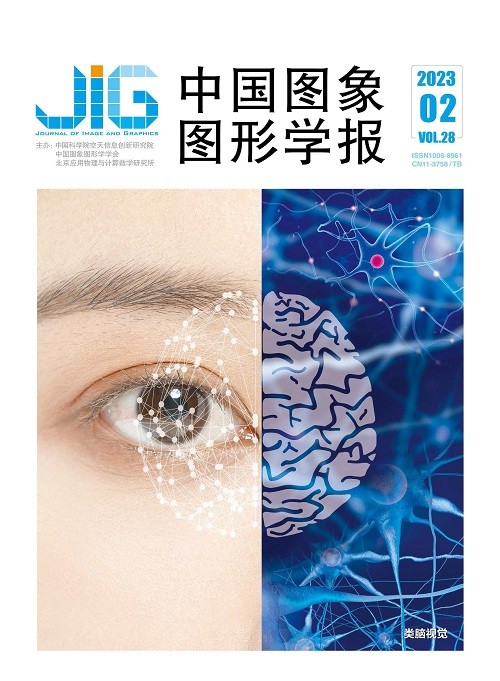
高光谱图像非负稀疏分量分解建模与鲁棒性解混方法
摘 要
目的 高光谱解混是高光谱遥感数据分析中的热点问题,其难点在于信息不充分导致的问题病态性。基于光谱库的稀疏性解混方法是目前的代表性方法,但是在实际情况中,高光谱数据通常包含高斯、脉冲和死线等噪声,且各波段噪声的强度往往不同,因此常用的稀疏解混方法鲁棒性不够,解混精度有待提高。针对该问题,本文对高光谱图像进行非负稀疏分量分解建模,提出了一种基于非负稀疏分量分析的鲁棒解混方法。方法 首先综合考虑真实高光谱数据的混合噪声及其各波段噪声强度不同的统计特性,在最大后验概率框架下建立非负矩阵稀疏分量分解模型,然后采用l1,1范数刻画噪声的稀疏性,l2,0范数刻画丰度的全局行稀疏性,全变分(total variation,TV)正则项刻画像元的局部同质性和分段平滑性,建立基于非负稀疏分量分析的高光谱鲁棒解混优化模型,最后采用交替方向乘子法(alternating direction method of multipliers,ADMM)设计高效迭代算法。结果 在2组模拟数据集上的实验结果表明,相比于5种对比方法,提出方法在信号与重建误差比(signal to reconstruction error,SRE)指标上比同类最好方法提升了4.11 dB;在不同噪声强度下,提出方法的SRE平均提升6.94 dB;在美国内华达州Cuprite矿区数据的真实数据实验中,提出方法也取得了较好的矿物解混性能。结论 提出方法综合考虑了高斯随机噪声和稀疏性结构噪声对解混精度的影响,具有较好的混合噪声自适应稳健处理能力,解混的精度比现有同类方法更高。
关键词
Non-negative sparse component decomposition based modeling and robust unmixing for hyperspectral images
Wang Shunqing, Yang Jingxiang, Shao Yuantian, Xiao Liang(School of Computer Science and Engineering, Nanjing University of Science and Technology, Nanjing 210094, China) Abstract
Objective Hyper-spectral remote sensing (RS) image based pixel issue is focused on the spectra of several elements-purified mixture in common restricted by the low spatial resolution of hyperspectral imagers and the diversity of spectral features in nature. The quality of hyper-spectral images (HSIs) is often constrained of mixed pixels. The development and application of RS-based hyper-spectral images is challenged for the constraints of mixed pixels. Hyper-spectral un-mixing problem is essential to hyper-spectral image analysis through decomposing mixed pixels into a set of pure substances (endmembers) and corresponding component ratios (abundances). The challenging issue of un-mixing is connected with insufficient and unmatched information problem. At present, the hyper-spectral un-mixing content is required to segment into three categories:1) geometry-based, 2) statistics-based, and 3) spectral profiles-based. The spectral profiling is relevant to a pre-collected spectral library composed of a large number of elements-purified spectra as an end-member dictionary. It is not necessary to extract end-members from hyper-spectral data, and the following influence of inaccurate end-member extraction can be avoided. Generally, the number of end-members in the spectral library is more than the end-members-related amount in a hyper-spectral image, which make richer matrix more sparsely. To improve the un-mixing accuracy, the constraints-sparsely is required to be added in terms of richer matrix. In addition, HIS-based spatial information can aid to the improvement of un-mixing accuracy greatly. In reality, hyper-spectral data quality is constrained of multiple noises because the photonic energy is limited in imaging process, such as Gaussian, impulse and deadline noise, and each band of noise-intensified. However, most of un-mixing problems are relevant to Gaussian noise and the other types of noise like impulses and deadlines are not involved in, and the assumption of Gaussian noise intensity is for the same bands of hyper-spectral data. In order to resolve the problems mentioned above, we develop non-negative sparse component decomposition, and a robust un-mixing to sparse component analysis (RUnSCA) for hyper-spectral images. Method First, the application of mixed noise of real hyperspectral data and the statistic features of different noise intensity of each band are involved in. Then, we carry out a non-negative sparse component-based model analysis in terms of the maximized posterior probability framework. The hyper-spectral data quality of each band is improved further when the mixed noise is as the linear combination of spectra in a profile. Considering the sparsity nature of impulse noise and deadline noise, the l1,1 norm is as the constraints of these noises. Since the number of endmembers in the spectral library is more than the number of end-members in the hyper-spectral image, a smaller number for non-zero rows can be existed in the abundance matrix, which means the abundance has global row sparsity. In order to analyze the sparsity of the abundance matrix more effectively, we introduce l2,0 norm constraint to the abundance matrix for mining the global row sparsity. In hyper-spectral images, adjacent pixels-local contains mutual substances, and their spectra should be similar mutually, so the image can show smoothness-piecewise. The abundance matrix is regarded as piecewise smooth as well because the elements in each column of the abundance matrix represent the proportion of corresponding objects in a pixel. The factor of total variation regularization (TV) is added to the model analysis. Finally, the proposed RUnSCA problem can be resolved in terms of the alternating direction multiplier method (ADMM). Result In order to verify the effectiveness of the proposed RUnSCA, we use two sorts of simulated data sets and one real data set in experiment. We use signal to reconstruction error (SRE) for evaluating the performance of un-mixing as well. There are five representative methods used in the comparative experiments. The methodology is based on collaborative sparse theory of those are variable-split-coordinated sparse un-mixing and augmented Lagrangian (CLSUnSAL) and sparse-cooridinated hyper-spectral un-mixing using l0 norm (CSUnL0). Sparse un-mixing problem is resolved via variable-split and Lagrangian-augmented and total variation (SUnSAL-TV), and the row-sparsity spectral un-mixing is resolved via total variation (RSSUn-TV). Sparse un-mixing of hyper-spectral data with bandwise model (SUBM) is also be considered as the variation of Gaussian noise in different bands of hyper-spectral image and the impulse noise or deadlines is taken into account. On the two simulated data sets, in comparison with the best result of five popular methods, the experiments show that our SRE result can improve 4.11 dB and 6.94 dB on average under various noise intensities. It illustrates the proposed method can deal with it more robustness. The RUnSCA also achieves good performance of mineral un-mixing on real data over Cuprite mine in Nevada, USA. The un-mixing performance-validated is based on a single mixed spectrum as well. The results show that the spectrum-reconstructed is closest to the real spectrum with the lowest RMSE. The RUnSCA can analyze the composition and proportion of the mixed spectra accurately. The experiments on simulated data and real data show that our analysis has more robustness over mixed noise. Conclusion This non-negative sparse component decomposition task demonstrate that a robust un-mixing for hyper-spectral images is effective with sparse component analysis (RUnSCA), which can comprehensively considers the influence of Gaussian random noise and sparse structural noise on the accuracy of linear un-mixing. The potential ADMM problem can be resolved further.
Keywords
hyper-spectral remote sensing linear hyperspectral unmixing sparse unmixing total variation (TV) alternating direction method of multipliers (ADMM)
|



 中国图象图形学报 │ 京ICP备05080539号-4 │ 本系统由
中国图象图形学报 │ 京ICP备05080539号-4 │ 本系统由